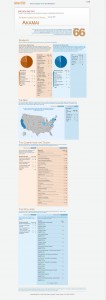 “We still have our work cut out for us in convincing companies how important it is to take a business intelligence mindset within HR.” That comment comes from Dr. Charles Handler, an I/O psychologist, who, contrary to the suggestion implicit in that comment, was actually encouraged by what he saw at HR Tech.
“We still have our work cut out for us in convincing companies how important it is to take a business intelligence mindset within HR.” That comment comes from Dr. Charles Handler, an I/O psychologist, who, contrary to the suggestion implicit in that comment, was actually encouraged by what he saw at HR Tech.
“After this year’s show I am smiling from ear-to-ear,” he wrote, in praise of how vendors are integrating and leveraging assessment data for “analytics and business intelligence.”
I saw what he saw, but from a different perspective; a perspective that encompassed the sweep of the showroom floor, and in-depth discussions with many of the largest vendors, and casual conversations with several others. What I sensed, more than saw, was that HR analytics are being understood as more than a measure of recruiting productivity.
Wanted Technologies is an example of how vendors are providing tools to access data and show its cross-departmental value.
The other day, Wanted added salary ranges to its AnalyticsT platform. AnalyticsT is a data product designed specifically for recruiters. It can tell you on a very granular level what the market supply is like for specific jobs; how many of those jobs are being advertised at that moment; what the trends been; and who is doing the hiring and how many positions they have.
Now with the addition of the salary range, recruiters can compare the going rate in their locale — or elsewhere — to what they’re offering.
A valuable tool for recruiters? Certainly. But it would be a shame if that intelligence stayed with HR. As Wanted’s President and CEO Bruce Murray said, “Talk about a seat at the table… They (HR professionals) can provide competitive intelligence on a company and get very detailed about it.”
 Wanted was one of the companies on my not-to-miss list for HR Tech. Alas, I did miss connecting with the company there, so our conversation the other day was about much more than the new salary addition.
Wanted was one of the companies on my not-to-miss list for HR Tech. Alas, I did miss connecting with the company there, so our conversation the other day was about much more than the new salary addition.
“These kinds of reports,” Murray was saying, “are the building blocks of HR providing business intelligence.”
Before going further, let me explain what Wanted’s AnalyticsT does. First, there’s the database of job listings going back years. The company’s roots are in collecting online sales information. Among other things, the company spidered listings of various types, cleaned it, sorted it, and sold leads to companies.
Its recruitment database goes back six years has 650 million job ads alone. From that job descriptions, titles, salaries, the company placing the ad, and other critical information has been extracted and indexed, making it possible for a recruiter in Milwaukee to learn how many game-level software developer jobs have been listed in the last several months, how the number has changed over time, what the pay is, and who’s doing the hiring.
There’s more than that available, but with just that much, HR can inform marketing and sales about what the competition is doing. Have salaries been going up? What’s the supply of potential candidates like? Critical information for managers of the development teams, which may need to adjust their pay scales or spend more time plumbing the career plans of their people with hard to find skills.
The AnalyticsT platform integrates with LinkedIn so recruiters can directly source candidates. The integration handles the supply side. Wanted’s job posting collection handles the demand side.
Other companies collect job listings, but Wanted is the only one to be vetted by The Conference Board, a private business organization that collects and distributes enormous amounts of economic information, including the widely quoted Consumer Confidence Index. It’s from Wanted that The Conference Board gets its data for the monthly Help Wanted OnLine Data Series.